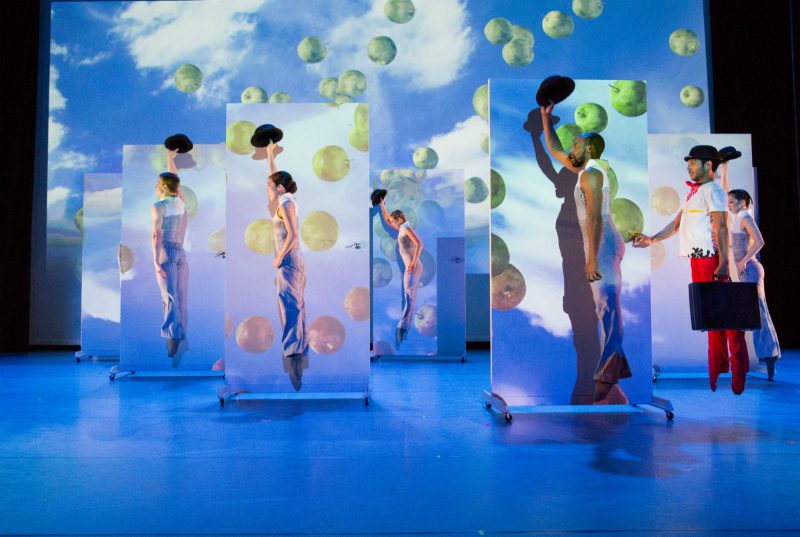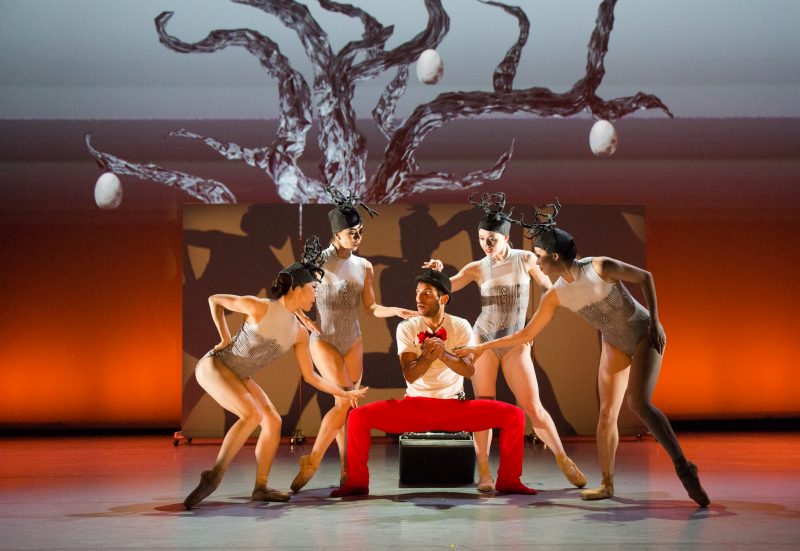What happens when you combine an intensely physical and embodied art form like dance with disembodied video projection? For its tenth anniversary, BalletX has taken on the challenge of combining these media in a pair of world premieres created in collaboration with the digital art and advertising organization, Klip Collective. The program that I saw Saturday night opens with Matthew Neenan’s “Identity Without Attribute,” a work in 5 acts that explores the life and art of longtime BalletX supporter Toni Hamilton who documented her gradual memory impairment in her journal. In the second piece, “Bonzi,” Amsterdam-based choreographer Annabelle López Ochoa explores the visual world of Belgian surrealist painter René Magritte (d. 1967). This inventive choreography is brought vividly to life by the dancers of BalletX, whose skill and athleticism is matched by the utter joy they bring to the performance.

Visual and visceral
The integration of the visual and the visceral was particularly successful in “Bonzi,” whose titular character (dancer Edgar Anido) is a traveling salesman who leads a humdrum life trying to sell people things they neither want nor need. At the start of the performance, the bowler-hatted Bonzi knocks on a plain white door and sets in motion a series of surreal vignettes involving multiple doors, bowler hats, apples, and eggs–all motifs familiar from the paintings of Magritte. Dancers hiding behind movable doors on casters swirled around the stage, dazzling poor Bonzi as well as the audience. With constant costume changes and the clever use of props, the dancers playfully shift personas from alluring coquettes with quixotic tree-like headgear circling around Bonzi, to a self-contained corps of dancers that largely ignores him. By the end of the performance, Bonzi seems to enter the dancers’ madcap surreal world, leaving behind his heavy black briefcase with unrestrained glee.

In the conversation with the artists that took place before the opening night on July 6, López Ochoa made it clear that she is “not a ballerina.” She takes advantage of a wide range of dance traditions, from classical ballet to hip hop styles, and the dancers seemed equally at home in all these genres–and in all sorts of footwear, from nearly invisible socks to traditional pointe shoes. The video projections incorporated allusions to specific works by Magritte, but wisely avoided simple two-dimensional projection of his paintings as a backdrop, instead fluidly incorporating different elements into a coherent whole. The bowler-hatted bourgeois businessman that appears in so many of Magritte’s paintings, together with cloudy blue skies and perfectly green apples, act as visual motifs that tie the piece together. The video projections worked beautifully and turned the blank white surface of the doors into moving pictures that blurred the distinction between motion and stillness, foreground and background, and two- and three-dimensional space. The music, selected by López Ochoa, was a mixture of jazz and electronic sounds with the occasional Classical motif thrown in. The music, clever use of props, and the visual elements all complemented the inventive choreography, creating a compelling performance that had me smiling the whole time in sheer delight at the artistry of the dancers and choreographer.

Mind/body
Matthew Neenan’s “Identity Without Attribute” was a much different experience, a solemn psychological study of Toni Hamilton’s struggle to retain control over her identity and memories as she suffers from a gradual memory loss. Dancer Caili Quan embodies Hamilton at various points during her life, dancing her heart out in a very challenging role that has her combining athletic virtuosity and emotional intensity. Neenan focuses on the relationship among pairs and small groups of dancers, underscoring the themes of interiority and subjectivity. To my eyes, however, these themes were most effectively conveyed by the passages involving the entire corps of dancers, who work together so smoothly that they move like one body. The video projections were much more spare and two-dimensional than in “Bonzi,” and the dancers were so wrapped up in their own interiority that they scarcely interacted with the slowly rotating geometric shapes on the screen in the background. While this alienation from their surroundings may have been deliberate, it left me feeling as though the visuals were somewhat superfluous. The hard-edged spiral shape in particular, that seems a visual metaphor for memory loss, might have provoked a choreographed response. The repetitive electronic music, which was also composed by Klip Collective, contributed to the austere, cold feeling of alienation that dominated the mood of the piece.
The dancers of BalletX are absolutely spectacular, both individually and as a whole. They give themselves fully to their roles, and in the intimate space of The Wilma Theater they really connect with the audience. The divergent moods of these two pieces demanded a great deal from the dancers–after the intensity of “Identity Without Attribute,“ which was the longer of the two pieces, the audience was ready for the spirited fun of “Bonzi.” Each of the works could stand alone or in combination with others in a different program, but these two diverse pieces underscore the creative range of BalletX as a whole. They form a fitting diptych to celebrate this innovative company’s first decade on the Philadelphia dance scene, and I hope BalletX is around for many years to come.
BalletX’s Summer Series continues from Wednesday, July 13 through Sunday, July 17. Performances take place at The Wilma Theater, 265 S. Broad St., Philadelphia.









